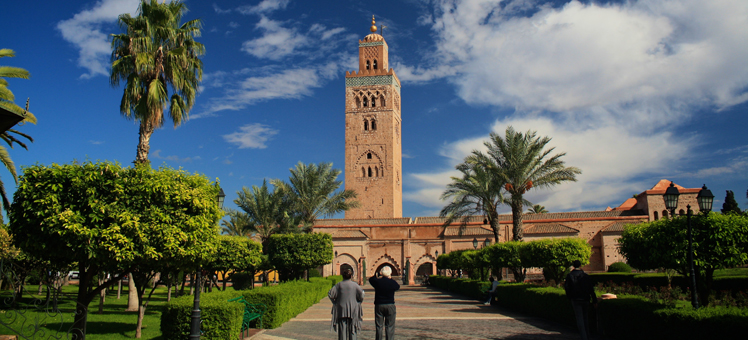
Like one of the Islamic frescoes at the mosque, Marrakech is intricate and multilayered. Though it may appear as utter chaos at first, it is made up of many beautiful elements. The central square of the medina, Djemaa El-Fna, is the beating heart of the city, a constantly changing cityscape throughout the day and night. Pockets of tranquility can be found across the city, away from the crowds, with majestic palaces and gardens to explore. Look closely enough, and Marrakech will start to reveal her charms.
Djemaa El-FnaPresided over by the Koutoubia Mosque, Djemaa El-Fna is Marrakech’s main square. In the first light of dawn, as the muezzin sounds the call to prayer, orange juice sellers arrive. Before long, the whole vast plaza is bustling. Charming girls flutter their eyelashes as they try to scrawl henna on your arm, water sellers in exuberant costumes pose for photos, a dentist sits cross-legged on the ground, proudly displaying his pliers and the teeth he has already pulled. But the main event is at night. Makeshift restaurants take over, plastic chairs and trestle tables set up in the blink of an eye, the chefs quickly filling the air with sizzling smells.
El Badi and Bahia Palaces
El Badi, meaning ‘the incomparable’, was at one time the most opulent palace in Marrakech. It is still an impressive sight, though its gold and marble adornments are no more. Only the bare structure of blush-colored stone and a vast, empty courtyard remains. Climb up to the ramparts to take in the views across the city, where you can really appreciate the uniform pink stone, and listen to the odd, clattering sound of the storks, who keep guard on the highest walls. Nearby, the more recent Bahia (brilliant) palace still retains its stunning Islamic frescoes. It was once a harem, with the concubines’ rooms organized around a beautiful central courtyard.
Jewish Quarter
The Jewish Quarter, or Mellah, offers an interesting glimpse into the culture of Marrakech’s non-Muslim minority. The area occupies a tight network of streets between the El Badi and Bahia palaces, much quieter than other parts of the medina. The synagogue is a domed building located in a small, peaceful square. As long as visitors are respectful, they are welcome to enter the synagogue, and the rabbi is happy to explain about the Mellah. The courtyard is a beautiful, vibrant blue, a contrast to the subdued exterior. The Jewish cemetery is worth a visit, with its prism-shaped tombstones, some dating back to the medieval times.
Majorelle Gardens
Just north of the medina, within the Gueliz district, the Majorelle Gardens offer an oasis of lush greenery and tranquility amid the heat and dust. Cacti, palms and climbing plants flourish around the walkways, punctuated with lily-strewn ponds and decorative fountains. The main sight is the Blue House, now containing the Museum of Islamic Art. So iconic is the vibrant shade of cobalt that it is known as Majorelle Blue. The gardens have serious artistic pedigree: designed by the artist Jacques Majorelle, who chose the blue color, they were later owned by Yves-Saint Laurent, whose ashes are scattered here. The museum is fascinating and the gardens a sheer delight.